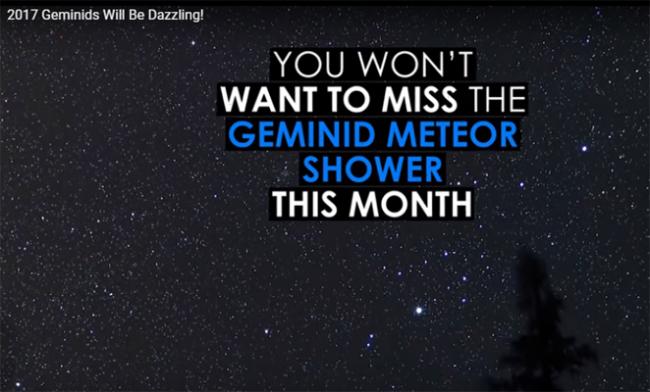
NASA asks skywatchers to gear up to experience best meteor shower next week
Washington, Dec 9 (IBNS): Maybe you've already seen a bright meteor streak across the December sky? The annual Geminid meteor shower has arrived. It's a good time to bundle up, go outside and let the universe blow your mind!
"With August's Perseids obscured by bright moonlight, the Geminids will be the best shower this year," said Bill Cooke with NASA's Meteoroid Environment Office. "The thin, waning crescent Moon won't spoil the show."
The shower will peak overnight Dec. 13-14 with rates around one per minute under good conditions, according to Cooke. Geminids can be seen on nights before and after the Dec. 14 peak, although they will appear less frequently.
"Geminid activity is broad," said Cooke. "Good rates will be seen between 7:30 p.m. on Dec. 13 and dawn local time the morning of Dec. 14, with the most meteors visible from midnight to 4 a.m. on Dec. 14, when the radiant is highest in the sky."
About the Geminid Shower
The Geminids are active every December, when Earth passes through a massive trail of dusty debris shed by a weird, rocky object named 3200 Phaethon. The dust and grit burn up when they run into Earth's atmosphere in a flurry of "shooting stars."
"Phaethon's nature is debated," said Cooke. "It's either a near-Earth asteroid or an extinct comet, sometimes called a rock comet."
As an added bonus this year, astronomers will have a chance to study Phaethon up close in mid-December, when it passes nearest to Earth since its discovery in 1983.
Meteor showers are named after the location of the radiant, usually a star or constellation close to where they appear in the night sky. The Geminid radiant is in the constellation Gemini.
The Geminids can be seen with the naked eye under clear, dark skies over most of the world, though the best view is from the Northern Hemisphere. Observers will see fewer Geminids in the Southern Hemisphere, where the radiant doesn't climb very high over the horizon.
Observing the Geminids
Skywatching is easy. Just get away from bright lights and look up in any direction! Give your eyes time to adjust to the dark. Meteors appear all over the sky.
Not all the meteors you might see belong to the Geminid shower, however. Some might be sporadic background meteors, and some might be from weaker, active showers like the Monocerotids, Sigma Hydrids and the Comae Berenicids.
"When you see a meteor, try to trace it backwards," said Cooke. "If you end up in the constellation Gemini there's a good chance you've seen a Geminid."
Learn More about the Geminids
Cooke and other meteor experts from NASA's Meteoroid Environment Office will be live on Facebook to discuss the Geminids and why meteors and meteoroids are important to NASA beginning at 8 p.m. EST on Dec. 12.
And if it's cloudy where you are, NASA will broadcast the Geminid shower live via Ustream starting at sunset Dec. 13 from the Automated Lunar and Meteor Observatory at NASA's Marshall Space Flight Center in Huntsville, Alabama.
You can also see Geminid meteors on NASA’s All Sky Fireball network page. Follow NASA Meteor Watch on Facebook for information about meteor showers and fireballs throughout the year.
Image: NASA website
Support Our Journalism
We cannot do without you.. your contribution supports unbiased journalism
IBNS is not driven by any ism- not wokeism, not racism, not skewed secularism, not hyper right-wing or left liberal ideals, nor by any hardline religious beliefs or hyper nationalism. We want to serve you good old objective news, as they are. We do not judge or preach. We let people decide for themselves. We only try to present factual and well-sourced news.







